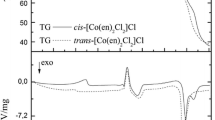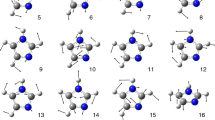Abstract
This paper describes syntheses and structure determination of four lanthanide complexes [Nd(2-Cl-4-FBA)3phen]2 (1, 2-Cl-4-FBA = 2-chloro-4-fluorobenzoate, phen = 1,10-phenanthroline), [Ln(2,5-DClBA)3phen]2 (Ln = Sm(2) and Tb(3), 2,5-DClBA = 2,5-dichlorobenzoate) and [Sm(2-Cl-4,5-DFBA)3(phen)(H2O)]2 (4, (2-Cl-4,5-DFBA = 2-chloro-4,5-difluorobenzoate). The complexes were characterized by elemental analysis, infrared and ultraviolet spectra, and X-ray single-crystal diffraction. In the molecular structures of 1–4, two Ln3+ ions are linked by four carboxyl groups, with two of them in a bridging bidentate mode and the other two in a bridging-chelating tridentate mode, forming four binuclear molecules. In addition, each Ln3+ ion is also chelated to one phen molecule and one carboxyl group in the complexes, except each Sm3+ ion in 4 which is bonded to one carboxyl group by unidentate mode and one H2O molecule. There are two different coordination polyhedrons for each Nd3+ ion in the two similar molecular structures of 1 and they are a distorted monocapped square antiprismatic and a distorted tricapped triangular prism conformation, respectively. The coordination polyhedron for each Ln3+ ion in 2–4 is a nine-coordinated distorted mono-capped square antiprismatic conformation. The complex 3 exhibits green luminescence under the radiation of UV light. The thermal decomposition behaviors of the complexes have been discussed by simultaneous TG/DSC-FTIR technique. The 3D surface graphs for the FTIR spectra of the evolved gases were recorded and the gaseous products were identified by the typical IR spectra obtained at different temperatures from the 3D surface graphs. Meanwhile, we discussed the non-isothermal kinetics of 1–4 by the integral isoconversional non-linear (NL-INT) method.
Similar content being viewed by others
References
Li X, Shi Q, Sun DF, Bi WH, Cao R. Synthesis and characterization of a series of lanthanide complexes constructed from orotic acid. Eur J Inorg Chem, 2004 (13): 2747–2753
Tian L, Ren N, Zhang JJ, Liu HM, Bai JH, Ye HM, Sun SJ. Synthesis, crystal structure, luminescence and thermal decomposition kinetics of Eu(III) complex with 2,4-dichlorobenzoic acid and 2, 20-bipyridine. Inorg Chim Acta, 2009, 362: 3388–3394
Ye HM, Ren N, Zhang JJ, Sun SJ, Wang JF. Crystal structures, luminescent and thermal properties of a new series of lanthanide complexes with 4-ethylbenzoic acid. New J Chem, 2010, 34: 533–540
Li X, Li YQ, Wu XS. 1-D and 2-D lanthanide coordination polymers constructed from 4-sulfobenzoate and 1,10-phenanthroline. Inorg Chem commum, 2008, 11: 774–778
Bettencourt-Das AD. Isophthalato-based 2D coordination polymers of Eu(III), Gd(III), and Tb(III): Enhancement of the terbium-centered luminescence through thiophene derivatization. Inorg Chem, 2005, 44(8): 2734–2741
Wan YH, Jin LP, Wang KZ, Zhang LP, Zheng XJ, Lu SZ. Hydrothermal synthesis and structural studies of novel 2-D lanthanide coordination polymers with phthalic acid. New J Chem, 2002, 26(11): 1590–1596
Wang CG, Xing YH, Li ZP, Li J, Zeng XQ, Ge MF, Niu SY. A series of three-dimensional lanthanide-rigid-flexible frameworks: Synthesis, structure, and luminescent properties of coordination polymers with 2,5-pyridine dicarboxylic acid and adipic acid. Crys Growth De, 2009, 9(3): 1525–1530
Huang CH. Coordination Chemistry of Rare Earths. Bingjing: Science Press, 1997. 378
Gao C, Cui K, She JB, Hou CQ, Guo HY, Zhao W, Wei W, Peng B. Optical properties of a novel neodymium pentafluoropropionate binuclear complex. Inorg Chim Acta, 2009, 362: 2001–2005
Yang SP, Yang H, Yu XB, Wang ZM. Synthesis, structure and fluorescence of Eu2(NAP)6(PHEN)2 (NAPH = α-naphthoic acid; PHEN = 1,10-phenanthroline). J Mol Struct, 2003, 659: 97–102
Yan B, Zhang HJ, Wang SB, Ni, JZ. Intramolecular energy transfer mechanism between ligands in ternary rare earth complexes with aromatic carboxylic acids and 1,10-phenanthroline. J photochem photobiol A: Chem, 1998, 116: 209–214
Zolin V, Puntus L, Kudryashova V, Tsaryuk V, Legendziewicz J, Gawryszewska P, Szostak R. Charge transfer bands in the luminescence excitation spectra of isomeric pyridinedicarboxylic salts of europium. J Alloys Compd, 2002, 341: 376–380
Bakhtiar R, Ochiai EI. Pharmacological applications of inorganic complexes. Gen Pharmacol, 1999, 32: 525–540
He QZ, Yang J, Min H, Li HX. Studies on the spectra and antibacterial properties of rare earth dinuclear complexes with L-phenylala-nine and o-phenanthroline. Mater Lett, 2006, 60: 317–320
Premkumar T, Govindarajan S. Antimicrobial study on trivalent lighter rare-earth complexes of 2-pyrazinecarboxylate with hydrazinium cation. World J Microbiol Biotechnol, 2006, 22: 1105–1108
Breen C, Last PM, Taylor S, Komadel P. Synergic chemical analysis — The coupling of TG with FTIR, MS and GC-MS 2. Catalytic transformation of the gases evolved during the thermal decomposition of HDPE using acid-activated clays. Thermochim Acta, 2000, 363: 93–104
Xie W, Pan WP. Thermal characterization of materials using evolved gas analysis. J Therm Ana Cal, 2001, 65: 669–685
Li J, Liu YW, Shi JY, Wang ZY, Hu L, Yang X, Wang CX. The investigation of thermal decomposition pathways of phenylalanine and tyrosine by TG-FTIR. Thermochim Acta, 2008, 467: 20–29
Sheldrick GM. SHELXS 97, Program for the Solution of Crystal Structure. Germany: University of Gottingen. 1997
Sheldrick GM. SHELXL 97, Program for the Refinement of Crystal Structure. Germany: University of Gottingen. 1997
Shi YZ, Sun XZ, Jiang YH. Spectra and Chemical Identification of Organic Compounds. Nanjing: Science and Technology Press, 1988. 98
Bai GB, Chen GD, Wang ZM, Yuan L, Kang ZW, Gao JZ. Synthesis and characterization of Ln(III)-Glycine-1,10-phenathroline ternary chelates. Chin J Inorg Chem, 1988, 4(2): 32–41
An BL, Gong ML, Li MX, Zhang JM. Synthesis, structure and luminescence properties of samarium(III) and dysprosium(III) complexes with a new tridentate organic ligand. J Mol Struct, 2004, 687: 1–6
Wang LF, Wu JG, Peng ZR, Ran W, Yan GH. Study on ternary complexes of rare earth elements. IV. Syntheses and properties of ternary complexes of rare earth elements with 3,5-dinitrosalicylic acid and phenanthroline. Chin J Inorg Chem, 1990, 6: 141–146
Li X, Jin LP, Wan YH. Crystal structure and luminescence of a europium coordination polymer {[Eu(p-MOBA)3·2H(2)O]·0.5H2O 0.5(4,4′-bipy)}. Chin J Chem, 2002, 20: 352–357
Yin MC, Ai CC, Yuan LJ, Wang CW, Sun JT. Synthesis, structure and luminescent property of a binuclear terbium complex [Tb2(Hsal)8(H2O)2][(Hphen)2]·2H2O. J Mol Struct, 2004, 691: 33–37
Wang JF, Ren N, Zhang JJ, Wu KZ, Wang SP. Synthesis, crystal structure, and thermal properties of a holmium(III) benzoate complex with 1,10-phenanthroline. J Chem Eng Data, 2010, 55: 4982–4989
Vyazovkin S, Dollimore D. Linear and nonlinear procedures in isoconversional computations of the activation energy of nonisothermal reactions in solids. J Chem Inf Comput Sci, 1996, 36: 42–45
Vyazovkin S. Kinetic concepts of thermally stimulated reactions in solids: A view from a historical perspective. Int Rev Phys chem, 2000, 19: 45–60
Vyazovkin S, Wight CA. Model-free and model-fitting approaches to kinetic analysis of isothermal and nonisothermal data. Thermochim Acta, 1999, 340–341: 53–68
Lu ZR, Ding YC, Xu Y, Chen SH, Yu YP. Thermal behavior and decomposition kinetics. J Therm Anal Cal, 2003, 73: 333–340
Author information
Authors and Affiliations
Corresponding author
Rights and permissions
About this article
Cite this article
Wang, J., Li, H., Zhang, J. et al. Crystal structures and thermal decomposition mechanism of four lanthanide complexes with halogen-benzoic acid and 1,10-phenanthroline. Sci. China Chem. 55, 2161–2175 (2012). https://doi.org/10.1007/s11426-012-4595-9
Received:
Accepted:
Published:
Issue Date:
DOI: https://doi.org/10.1007/s11426-012-4595-9




